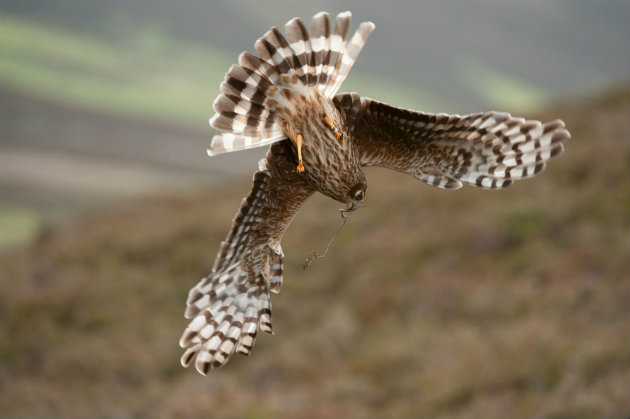Have you seen a hen harrier?
As a project to monitor hen harrier numbers in Scotland enters its third year, Tim Baynes looks at what the results have revealed so far

The hen harrier has a huge global range, from Europe to Taiwan, with an estimated European population of 30,000 to 54,000 breeding pairs (BirdLife International, 2015). However, at the last national survey in 2010, the UK population was 662 breeding pairs, 505 pairs of which were in Scotland with strongholds in the north and west.
A better idea of current numbers will emerge when the results of the 2016 UK harrier population survey are published, but the overall picture is expected to be broadly the same in Scotland. Harriers are still something of an enigma, with breeding naturally fluctuating from year to year, depending on a range of factors — from the cyclical number of voles for food supply to weather and habitat changes.

A hen harrier feeding on rabbit
As a Schedule 1 bird (protected under the Wildlife and Countryside Act 1981 as amended by the Environmental Protection Act 1990), there is a strong reason to ensure its satisfactory conservation status and an initiative was set up in 2015 to focus efforts on achieving this. Run by the Partnership for Action against Wildlife Crime Scotland (PAWS), Heads Up For Harriers is co-ordinated and funded by Scottish Natural Heritage (SNH) and supported by Scottish Land & Estates and the RSPB. Three independent harrier experts are employed on a part-time basis by the project.
PAWS for thought
The first objective is to raise public awareness of harriers by giving out information on the PAWS website and by distributing press releases, encouraging sightings to be reported in to a central resource. This information is collated and a map of sightings is available on the PAWS website. This year there has also been an effort to encourage land managers to be mindful when doing muirburn of leaving some long-heather habitat for harrier nesting, which also benefits merlin and short-eared owls.
The second objective is to find out more about reasons why nesting attempts fail. This was always thought to be a combination of illegal killing or disturbance, natural predation, poor food supply and cold, wet weather, but little was known as to how these factors interact. So estates with likely harrier nesting sites have volunteered to have time-lapse cameras installed next to nests that can record what happens right up until fledging. In the first two years, the identified reasons for nest failure have all been due to weather and fox predation, with some dramatic footage of a young fox attacking a nest in 2016.
Good relationships
Estates, some active grouse moors and some not, have been willing to help. It started with six in 2015 and this year at least 15 estates have volunteered, covering a total area of 325,000 acres. Ten of these, covering around 225,000 acres, are in the east of Scotland where harrier numbers are relatively low. Good relationships have been built up between estates and the SNH staff who manage the cameras, which is in itself a model for future co-operative working.
It is acknowledged that hen harriers do prey on game and other moorland birds. With a large staple of hen harrier nestling diet comprising young meadow pipits, grouse chicks and voles, it may seem counterintuitive for an estate to volunteer for this project. The Joint Raptor Study at Langholm Moor in the 1990s looms over this whole subject, with a clear lesson that the later Langholm Moor Demonstration Project has largely confirmed. However, Scottish moorland managers have bought into Heads Up for Harriers to have definite information in an area that is too dominated by historical controversy, and to give a lead in working constructively with SNH to resolve it.

Hen harrier with chicks
Grouse moor management and the public benefits that flow from it are too important to risk being lost through a policy impasse. They recognise that it is vital in order to ensure a sustainable future for the hen harrier and for management of moorland for grouse and other bird species. With the evidence from two long-running projects at Langholm Moor and the five hen harrier special protection areas in Scotland, knowledge about harriers in the UK uplands is improving all the time. SNH and the grouse management sector now need to take those results and work together to develop a coherent long-term policy.
Scottish shooters condemn illegal killing of raptors
The shooting community has condemned the illegal killing of birds of prey after a new report into the disappearance of…
Heads Up For Harriers also complements the efforts in England led by DEFRA under the six-point Hen Harrier Action Plan to improve harrier conservation, while also ensuring a viable future for grouse moor management.
Indications at the time of writing are that the number of active harrier nests being monitored by Heads Up For Harriers cameras in 2017 is much the same as for 2016, but we will have to wait until August to know how successful breeding has been and what reasons for any failures are identified from the cameras. The project will publicise results at that time.
Tim Baynes is director of the Scottish Moorland Group, part of Scottish Land & Estates.









